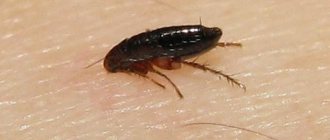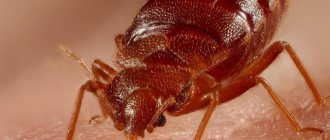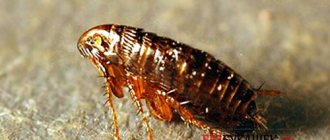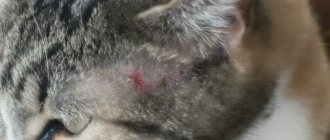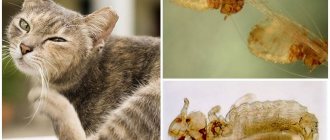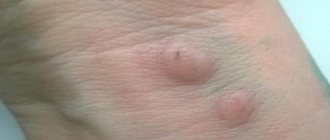The appearance of black grains in a cat's fur does not bode well. Unless it's dirt from your last walk (which is unlikely, given that most pets never leave their home). Scary thoughts immediately come to mind about parasites that you can become infected with without even going outside. Particularly dangerous are cases when the animal ruptures the lesions until they bleed and there is a risk of secondary infection, which significantly complicates the diagnosis and rapid recovery.
List and description of possible causes
It’s rare that owners bring their cat to the veterinarian complaining that it has black specks in its fur. Usually they complain of severe itching and non-healing wounds after severe scratching. If these and other symptoms are present, the following diseases should be excluded:
- Demodecosis. Contrary to the erroneous opinion of some veterinarians, this disease still affects cats, although much less frequently than dogs. Demodex (Demodex cati) is considered a habitual inhabitant of the skin and normally does not cause any pathological manifestations. His activity is always provoked by something. Usually these are recent diseases of the internal organs, the postoperative period, prolonged use of antibiotics or severe hormonal fluctuations. All this manifests itself in the appearance of black grains in the cat’s fur, which are not accompanied by itching. It is important! But demodicosis causes the appearance of large bald spots (in severe cases, even partial baldness), in place of which small black dots appear. There is also the concept of juvenile demodicosis, which occurs in kittens aged 2-6 months. It usually affects the chin and flexor limbs. In most cases, it goes away on its own without the use of any medications. It is noted that demodicosis occurs more often in decorative breeds (Scots, British, Sphynx, Siamese).
- Flea dermatitis. Another reason why a cat may have black spots under its fur. A distinctive feature is that the parasites themselves may not be on the animal, since one bite is enough to provoke an allergic reaction to the flea’s saliva. The pet begins to behave restlessly, scratching its ears or chin (most often).
- Food allergies. A common phenomenon among decorative breeds. The slightest disturbance in the diet can provoke a severe allergic reaction, which manifests itself in the appearance of black grains in the fur, flaking, redness and hair loss (in some cases in clumps). The allergen is determined by exclusion, but most often the owners have to solve the problem for life with the help of drugs against itching and inflammation.
- Fleas. A real nightmare for cats of all ages. Even if you don't see them on your pet, it doesn't mean that fleas aren't biting him. You can get infected from other animals (dogs) or through objects brought from the street (even the soles of your shoes can have parasites). There are many cases when fleas were brought home along with the grass that cats love to eat in the spring and summer. At first, you may notice that your pet begins to itch more than usual (most attention is paid to the face). Over time, you may notice the appearance of black grains of sand under the fur, which fall off the animal after each stroking or combing. Large bald patches begin to appear due to scratching. In these places, brown-black crusts form on the skin due to claw wounds. The most correct solution would be to immediately treat all animals that have access to each other with anti-parasite drugs. Drops on the withers of Stronghold and Frontline are excellent against fleas and ticks. Process 2 times a month. Much attention is paid to the disinfection of housing, which is carried out using Parastop.
- Bacterial damage. A common occurrence in animals predisposed to allergies. Constant itching leads to deep calculations through which infection enters. Wounds can fester and take a long time to heal. Using cytology, the pathogen is determined and effective anti-inflammatory drugs are selected. In severe cases, antibiotic therapy is used.
- Dermatophytosis. A fungal infection that affects the cat's fur and skin. Small black grains and redness can be found at the site of the lesion. As the process progresses, the affected area transforms into a weeping wound the size of an egg. Severe itching leads to deep scratching and the process spreading to other parts of the body. Most often, pets who have free access to the street and, accordingly, to stray animals suffer. To confirm the diagnosis, a deep pluck is taken from the lesion for microscopic examination. This area can also be illuminated under a Wood's lamp, which will show a bright green glow if there are fungal spores in the fur. Treatment is long, with the use of antifungal drugs in the form of tablets, ointments and shampoos. To avoid relapse, all places with which the infected animal comes into contact are thoroughly washed with water and bleach and chlorhexidine.
Symptoms
If black specks appear on a cat's skin, the pet owner should check for other symptoms of the disease. For example, a cat may suffer :
- baldness;
- swelling of the body;
- redness of the skin;
- small pimples that increase in size and number over time.
Pay attention to your pet's behavior. The appearance of black dots on a cat’s body is often accompanied by itching, due to which the animal becomes restless and constantly itches. Only an experienced veterinarian can make an accurate diagnosis after conducting the necessary research work.
Diagnostic results help to find out the exact cause of the appearance of dark spots on the fur and skin of a pet. It may turn out that the grains are due to the activity of parasites, a fungal infection, or as a result of a skin biopsy. A timely veterinary examination will allow you to exclude similar diseases, which include :
- demodicosis;
- cat scabies;
- dermatophytosis;
- allergic reactions;
- eosinophilic granuloma.
The black dots that appear under the cat's fur are most likely skin plugs clogged with excess sebum, or a manifestation of an internal disease.
© shutterstock
Black spots in a cat's fur
You should not expect that black specks in a cat’s fur will go away on their own, since without the use of modern drugs it is very difficult to get rid of parasites. Well, if it’s an allergic reaction, then you can do without dieting and switching to hypoallergenic food.
It's easy and interesting to communicate here. Join us!
my special flea shampoo helps
So this is flea poop (not eggs). You need to get rid of fleas and it will disappear by itself)!
Be sure to treat the room - 90% of fleas live on the furniture, the remaining 10 live on the cat. Neostomazan or Butox - an ampoule on a bucket, rinse everything.
my cat had the same thing.. they also thought it was dirt, but then they figured out to buy drops for fleas on the withers and it went away..
crazy, they keep cats at home!
This is flea excrement - digested blood. The best way to check is to comb some of this sand onto a white sheet of paper, drop some water and move it around the sheet. If the kitten becomes reddish, it is infected with fleas; the more excrement, the more fleas. In general, we need to save the mustachioed one, they apparently ate the poor thing.
He has fleas, and this is their waste product. Buy flea drops for the withers and treat the kitten.
People who have pets do not always pay due attention to their health. For example, many owners do not pay attention to the appearance of black spots in the fur of a cat. And this may be a consequence of improper care or indicate the development of various types of diseases.
This article will discuss in more detail the causes and symptoms of their appearance, as well as methods of treatment.
Diagnosis of the disease
If a vigilant owner notices that black spots on his cat’s tail have appeared relatively recently, then you should check whether they are traces of the vital activity of any parasites, for example, fleas.
In the form of a black dot, it may look like a parasite has pierced the skin, on top of which there is dried blood. If it is not blood, but acne - black dots, then in this case it would be most advisable to contact the nearest veterinary clinic.
Acne can appear on the tail of an animal during puberty , in which case you shouldn’t even worry about the cat, since over time a problem of this nature will disappear by itself. Therapy in this case will be necessary only if the blackheads cause inconvenience. Black dots can only confuse the cat owner, especially if the animal is a sphinx.
Before prescribing treatment for acne, any experienced veterinarian will scrape the cat's tail , or rather, from the place where the blackheads are located. This scraping will be carefully examined in laboratory tests using a microscope.
Symptoms of acne
The following symptoms are typical for this disease:
- Redness of the skin;
- The appearance of swelling in the area where blackheads accumulate;
- Development of ulcers, hair loss;
If left untreated for a long time, these symptoms often cause anxiety, the pet becomes nervous and irritable, and may show aggression. In addition, the cat begins to scratch the damaged area, thereby increasing the risk of a new infection and deterioration in overall health.
An examination by a specialist and taking a scraping will help rule out the presence of diseases with similar symptoms. These include:
- Diseases of the stomach and liver. Caused by poor diet or complications after an illness. Lead to rashes all over the cat's body.
- Demodecosis. Characterized by the presence of subcutaneous mites. It is characterized by the appearance of ulcers, itching and hair loss. Easily transmitted to other animals.
- Allergy. Common causes are a reaction to food, collar, litter. It is characterized by the appearance of pimples or black spots in the cat’s fur, redness of the skin and itching.
- Ringworm. The development is provoked by a fungus, as a result of which peeling and rashes appear on the cat’s skin, which lead to itching and baldness.
Treatment of the disease
To carry out therapy, the owner must try to create ideal sterile living conditions for his cat. You should also try to avoid harmful microorganisms getting into the area where blackheads are located.
All this can be achieved by daily carrying out the most common hygiene procedures:
- Washing with shampoo containing tar,
- Wiping the skin with a 3% solution of hydrogen peroxide.
Before carrying out the procedures, the hair on the tail should be shaved; this does not apply to sphinxes.
After sanitation, the upper keratinized layer of the skin dissolves using Salicylic acid. The next step will be the use of bactericidal drugs that promote a drying and healing effect (YAM Ointment, Zinerit).
In very severe advanced cases, a course of antibiotic therapy (Amoxiclav, Bicilin, Ampicillin, and so on) is used.
Cats' tails are cleaned using scrubs and lotions ; this procedure is carried out in a veterinary clinic. All medical cosmetic products are manufactured in laboratory conditions.
When treating black spots on a cat's tail, you should pay close attention to the animal's nutrition. Very often, it is poor food that can cause metabolic disorders in a cat and as a result the appearance of black spots on the tail.
At home, it is not recommended to squeeze out blackheads on a cat’s tail yourself, since if done incorrectly, the animal may get a skin infection instead of the expected recovery from acne.
In very severe advanced cases, a course of antibiotic therapy (Amoxiclav, Bicilin, Ampicillin, and so on) is used.
Black dots in a cat's fur photo
The cat has one testicle, has anyone encountered this?
Scottish Fold cat, 7 months old, we want to fire him, he has one testicle, I looked on the Internet, it says 2nd inside most likely and it needs to be cut out, it might turn into cancer, we took him to the best clinic in the city (even she is not so hot, I don’t want an old cat these doctors ruined it in other clinics, it’s all a detour or, at least there’s equipment here) they told us they won’t cut it out, because they don’t know where it is, the ultrasound won’t show it, it’s very small, and they’ll only cut off the one that’s hanging, but it will be possible to mark it doesn't matter. Has anyone encountered this?
We recommend reading: What Fleas Threaten
Woman.ru experts
Find out the opinion of an expert on your topic
Pukemova Olga
Psychologist. Specialist from the site b17.ru
Kostenich Lyudmila Stanislavovna
Psychologist, Art therapist. Specialist from the site b17.ru
Marina Aleksandrovna Baydyuk
Psychologist, Analytical psychologist. Specialist from the site b17.ru
Valeria Bertnik-Yuryeva
Psychologist, Psychologist-guide. Specialist from the site b17.ru
Nevzorova Sofya Igorevna
Psychologist. Specialist from the site b17.ru
Alina Sysoeva
Psychologist, Coach and Trainer. Specialist from the site b17.ru
Juran Marina Vladimirovna
Psychologist, Family child psychologist. Specialist from the site b17.ru
Ekaterina Alekseevna Vasyukhina
Psychologist, Crisis counseling. Specialist from the site b17.ru
Spiridonova Nadezhda Viktorovna
Psychologist. Specialist from the site b17.ru
Treatment of a pet for an ailment
After examination, a qualified specialist prescribes comprehensive treatment, which is carried out at home or in a veterinary clinic. It includes:
- Local processing. Tar soap, specialized shampoo, antiseptic solutions, and a bandage soaked in calendula tincture are used.
- Taking prescribed medications. Prescribed in more advanced cases, in the presence of the development of a secondary infection. A monthly intake of an individually selected vitamin complex is recommended.
- Injections. If necessary, medications are selected by the attending physician.
- Adjustment of the usual diet. During treatment and recovery, the pet is transferred to a low-fat diet.
Video text
Woke up, got dressed, Hands up, fashion for the nineties, cheesecakes, blueberries, sports club, little bear is baking bread, drawing a location design in the game Tangaria.com, sushi, pineapple cutlets, light through the leaves, 100k on the Beauty Guild channel, stroking a bumblebee, egg from the floor, eel, ►Subscribe to vlogs: https://youtube.com/ShtukensiaLIVE ❤ My website: https://shtukensia.com



